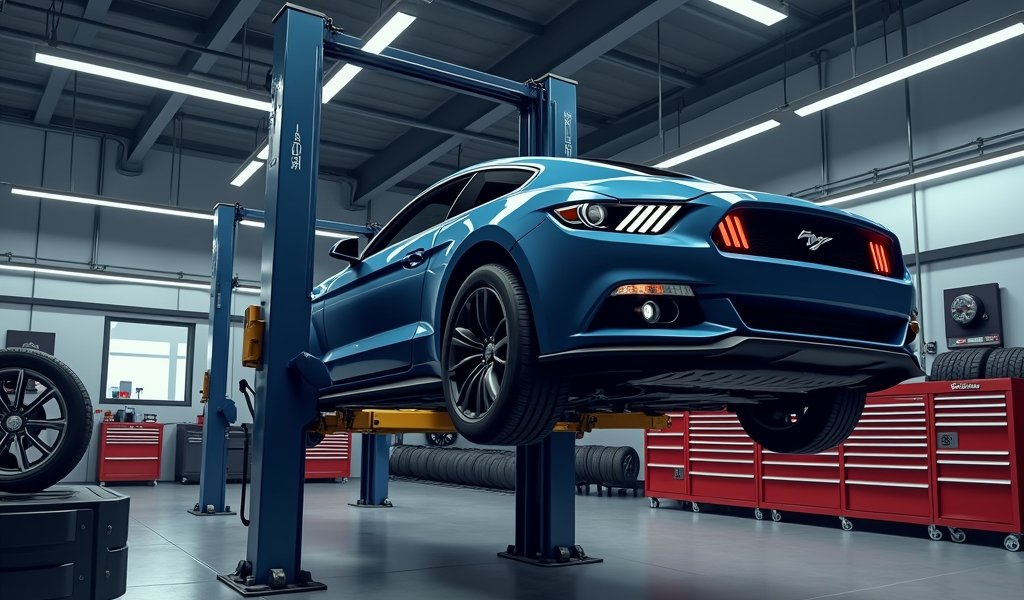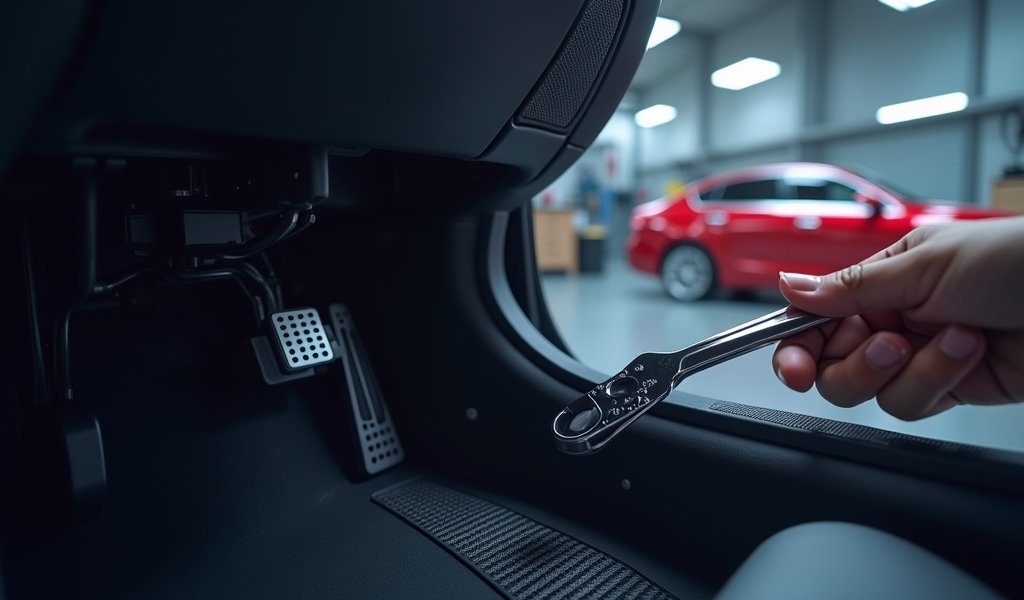Overview
Proper brake pedal free play (typically 1/4 to 1/2 inch of movement before engagement) is essential for vehicle safety, preventing premature brake wear, and ensuring optimal brake response. The article provides a mechanic’s guidance on recognizing when adjustment is needed, tools required, step-by-step adjustment tips, common mistakes to avoid, and when professional help is necessary.
Table of Contents
- Understanding Brake Pedal Free Play
- Why Proper Brake Pedal Free Play Matters
- Signs Your Brake Pedal Needs Adjustment
- Tools Needed for Brake Pedal Adjustment
- 5 Tips for Brake Pedal Free Play Adjustment
- Common Mistakes to Avoid
- When to Seek Professional Help
- Conclusion
- Frequently Asked Questions
Understanding Brake Pedal Free Play
Brake pedal free play is that little bit of movement you feel before your brakes actually start to engage. Think of it as the pedal’s “warm-up zone” – that initial travel where you’re pressing down but not yet slowing the car. As a mechanic with 15+ years in the shop, I can tell you that this seemingly minor detail can make a world of difference in your vehicle’s braking performance and safety.
Most folks don’t give brake pedal free play a second thought until something feels off. But this small adjustment is critical to your brake system’s overall health. When properly set, free play ensures your brake system isn’t constantly under pressure, which would cause premature wear and potentially dangerous brake fade.
The right amount of brake pedal free play adjustment varies between vehicles. Generally, you’re looking for about 1/4 to 1/2 inch of movement before you feel resistance. This sweet spot allows your brake light switch to function correctly while keeping your brake system ready to respond when needed.
Why Proper Brake Pedal Free Play Matters
Let’s talk brass tacks – why should you care about something as seemingly trivial as brake pedal free play? Well, when your pedal has too much free play, you’ll need to press it further before getting any braking action. This can be downright dangerous in emergency situations when every inch and millisecond counts. You might find yourself thinking “Why aren’t my brakes working?!” in a moment when you need them most.
On the flip side, too little free play means your brakes might be partially engaged even when you’re not pressing the pedal. This leads to constant brake drag, which will reduce your vehicle’s fuel efficiency and cause your brake pads, shoes, and rotors to wear out faster than a pair of cheap sneakers. I’ve seen plenty of folks puzzled by their vehicle’s poor gas mileage, only to discover their brakes were riding all along.
Proper adjustment also ensures your brake lights work as intended. Most vehicles have a brake light switch positioned near the pedal that activates when you begin braking. Too much free play could mean you’re braking but your lights aren’t telling the driver behind you – a recipe for a rear-end collision if there ever was one.

Signs Your Brake Pedal Needs Adjustment
Your car usually gives clear signals when brake pedal free play needs attention. Pay attention to these warning signs – they’re your vehicle’s way of asking for help before small problems become big ones.
A spongy or soft brake pedal that travels too far before engaging is the most common indicator. If you find yourself pushing the pedal nearly to the floor before feeling resistance, you’ve likely got excessive free play. This doesn’t just feel wrong – it is wrong, and potentially dangerous.
Another telltale sign is brake drag. Notice your vehicle seeming sluggish or your fuel economy taking a nosedive? Your brakes might be partially engaged due to insufficient free play. According to research from the Society of Automotive Engineers, even slight brake drag can reduce fuel efficiency by up to 3-5%.
If your brake lights are inconsistent – either staying on when you’re not braking or failing to illuminate when you are – the brake light switch might not be activating properly due to incorrect pedal free play. This is more than an annoyance; it’s a serious safety issue that could lead to traffic violations or worse, accidents.
Tools Needed for Brake Pedal Adjustment
Before diving into adjustment, let’s get your toolbox ready. The good news? You won’t need anything fancy for most vehicles. Here’s what typically does the job:
- Basic wrench set (both metric and standard)
- Pliers (preferably locking pliers)
- Measuring tape or ruler (for precise measurement of free play)
- Flashlight (for seeing those hard-to-reach spots)
- Jack and jack stands (if accessing from under the vehicle)
- Vehicle-specific manual (different vehicles have different specs)
For hydraulic brake systems, which most modern vehicles have, you might also need brake fluid (DOT 3, DOT 4, or DOT 5.1 depending on your vehicle’s requirements). Having a shop rag handy is always a good idea when working with fluids – brake fluid especially, as it can damage paint if spilled.
For older vehicles with mechanical brake linkages, you might need penetrating oil to free up rusty adjusters. When working on these classic systems, avoiding common maintenance mistakes becomes even more important, as replacement parts can be harder to find.
5 Tips for Brake Pedal Free Play Adjustment
Let’s roll up our sleeves and get to the heart of the matter. These five tips will guide you through a proper brake pedal free play adjustment, keeping your braking system in top shape for miles to come.
1. Consult Your Vehicle’s Service Manual First
Every vehicle has specific free play requirements, and guessing isn’t good enough when it comes to brakes. Your service manual will tell you the exact free play specification (typically 1/4″ to 1/2″) and the adjustment procedure for your particular model. If you don’t have the manual, most are available online through the manufacturer’s website or service portals like AllData DIY.
The manual will also show you where to find your brake pedal adjustment mechanism, which varies widely between makes and models. On some vehicles, it’s right at the pedal assembly under the dash, while others require accessing a master cylinder pushrod under the hood or adjusting a brake light switch position.
2. Measure Current Free Play Accurately
Before making any adjustments, get a baseline measurement. With the engine off, press the brake pedal slowly with your hand and measure the distance it travels before you feel resistance. This “slack” is your current free play.
For precise measurement, you can mark the pedal’s starting position and the point where resistance begins. The distance between these marks is your free play. Compare this to the specification in your manual to determine if adjustment is needed.
3. Adjust the Brake Light Switch Correctly
The brake light switch serves double duty – it activates your brake lights and often influences free play in modern vehicles. Typically mounted near the top of the pedal, this switch needs careful adjustment.
Most switches have a threaded body that screws in or out to adjust its position. Turn the switch clockwise to decrease free play or counterclockwise to increase it. Make small adjustments (quarter turns) and test after each change. The goal is having your brake lights come on just as the brakes begin to engage – not before, not after.
4. Fine-Tune Pushrod Length for Perfect Feel
In hydraulic brake systems, the master cylinder pushrod length directly affects free play. This adjustment is more involved but delivers precision results. You’ll usually find a locknut and threaded rod arrangement that allows you to lengthen or shorten the pushrod.
Always make small adjustments, checking the pedal feel after each change. Too short, and you’ll have excessive free play; too long, and you risk keeping the master cylinder partially engaged, leading to brake drag and overheating. This is where those service mistakes can be costly, so take your time and get it right.
5. Test, Readjust, and Verify
After adjustment, test the brakes thoroughly before hitting the road. With the engine running (for power brake systems), press the pedal several times to feel the engagement point. The pedal should have the specified free play before resistance, then firm up quickly without sponginess.
Check that the brake lights activate at the right moment and turn off when you release the pedal. If you’ve adjusted a hydraulic system, monitor your brake fluid level and watch for leaks for the next few days. Sometimes adjustments can disturb seals or fittings that had previously adapted to incorrect settings.

Common Mistakes to Avoid
Even experienced DIYers can slip up when adjusting brake pedal free play. Here are some pitfalls I’ve seen folks tumble into over the years – save yourself the headache!
The biggest mistake is overcorrecting. When you find excessive free play, it’s tempting to eliminate it completely. But remember, some free play is necessary. Eliminating it entirely causes constant brake drag, overheating, and premature wear. I once had a customer who “fixed” his spongy brakes by adjusting out all free play – he returned a week later needing new rotors and pads.
Another common error is adjusting the wrong component. Modern brake systems have multiple adjustable parts, and fiddling with the wrong one can cause more problems than it solves. I’ve seen people adjusting the proportioning valve when they should have been working on the brake light switch, creating dangerous braking imbalances.
Don’t forget that brake pedal free play can sometimes indicate deeper problems. If your adjustment doesn’t hold or quickly reverts to excessive play, you might have master cylinder issues, air in the lines, or leaks. Ignoring these underlying causes while repeatedly adjusting free play is like putting a band-aid on a broken bone – it won’t fix what’s really wrong.
When to Seek Professional Help
While I’m all for DIY spirit, there are times when it’s best to roll your vehicle into a professional shop. If you’re experiencing any of these scenarios, consider getting expert eyes on the problem:
- Your brake pedal goes to the floor even after proper adjustment
- You notice fluid leaks after attempting adjustment
- The pedal feels spongy despite eliminating excess free play
- Your vehicle pulls to one side during braking
- You hear grinding, squealing, or other unusual noises
These symptoms suggest issues beyond simple free play adjustment – possibly air in the lines, failing master cylinder, or hydraulic problems. Modern vehicles with anti-lock braking systems (ABS) or electronic brake force distribution have added complexity that sometimes requires specialized diagnostic equipment.
Remember, brakes aren’t where you want to cut corners. If you’re unsure about anything during the adjustment process, consult a professional. The cost of a brake inspection is minimal compared to the potential consequences of brake failure.
Conclusion
Brake pedal free play adjustment isn’t just another maintenance task – it’s a crucial aspect of your vehicle’s safety system that deserves attention. With the right tools and approach, you can maintain optimal free play and enjoy confident, responsive braking every time you hit the road.
Remember that proper brake pedal free play provides that sweet spot where your brake lights activate appropriately, your brakes respond promptly, and your brake components aren’t subjected to unnecessary wear. It’s that Goldilocks zone – not too much, not too little, but just right.
By following these five tips and avoiding common mistakes, you’ll ensure your vehicle stops reliably when you need it most. Whether you’re commuting through stop-and-go traffic or making an emergency stop to avoid a hazard, properly adjusted brakes respond predictably and effectively.
Check your brake pedal free play as part of your regular maintenance routine – it takes just a minute but pays dividends in safety and component longevity. Your brakes are your car’s most important safety feature, and they deserve this small but significant attention to detail.
Frequently Asked Questions
How much free play should a brake pedal have?
Most vehicles require between 1/4 to 1/2 inch (6-12mm) of free play. Always check your specific vehicle’s service manual for the exact specification.
Can I adjust brake pedal free play myself?
Yes, most brake pedal adjustments can be DIY projects if you have basic tools and mechanical knowledge. Complex brake systems or those with electronic components might require professional attention.
How often should brake pedal free play be checked?
Check brake pedal free play during regular maintenance, about every 6 months or 6,000 miles. More frequent checks are wise for older vehicles or those with known brake issues.
Will adjusting brake pedal free play fix a spongy brake pedal?
Not necessarily. While improper free play can cause some sponginess, this symptom often indicates air in the brake lines or other hydraulic issues. Free play adjustment alone won’t fix these deeper problems.
What happens if brake pedal free play is too tight?
Insufficient free play can cause brakes to drag, leading to overheating, premature wear of brake components, and reduced fuel economy. You might notice the vehicle feeling sluggish or brake components getting unusually hot.

